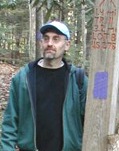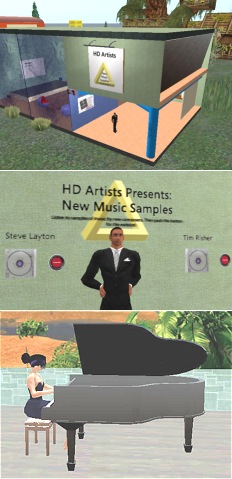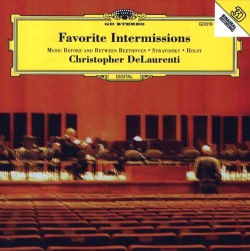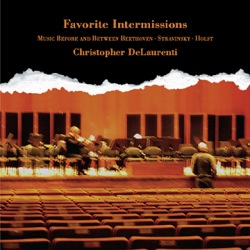I heard Gabriel Kahane at Joe’s Pub Wednesday night. If Billy Joel and Paul McCartney can write “classical music”, why can’t composers write “pop music”?
1. Gabe Kahane is a good singer, great pianist and out of this world showman. His wry and wonderful wit comes through his music and lyrics. Wednesday night Kahane shared his sounds with humor, humility and always in an entertaining way.
2. Ensemble with the four man band, including: piano, banjo, violin, clarinet, bass clarinet, drums, guitar, electric bass, toy piano and a melodic, was generally tight and toe tapping. Less stellar was the drummer playing banjo – it just didn’t click and wasn’t heard very well – perhaps it was his trip from Seattle. Later when Kahane picked up the banjo, it was heard fine and in time!
3. Rob Moose played excellent lines whether it was on violin, guitar or bass. Also Sam Sadigursky shone in his bass clarinet lines, and as a toy pianist, rocked the joint.
4. New songs including Keen were charming, including a Pan-Am bag on the subway inspired song written that day – although the riffs were cool, the selections weren’t always memorable.
5. The highlight of the evening was Kahane’s Craiglistlieder, a 21st Century masterpiece, both a virtuoso vehicle for Gabe singing and playing, and a biting commentary. Operatic riffs including pseudo recitative and rhythmic variety made this in a word, perfect.
The show was short but sweet – keep an eye out for the new album in August and go to http://www.gabrielkahane.com/ to experience the Craiglistlieder for yourself, you’ll be glad you did!
 Tim Risher is a composer that I bumped into a long time ago on this here web thingy. His illustrious career has taken him from making new music in Florida, to a long stint producing radio in Germany, to currently doing — well, something or other — in deepest, darkest Durham, North Carolina.
Tim Risher is a composer that I bumped into a long time ago on this here web thingy. His illustrious career has taken him from making new music in Florida, to a long stint producing radio in Germany, to currently doing — well, something or other — in deepest, darkest Durham, North Carolina.
One of Tim’s latest personal ventures involves the wildly-popular virtual world of Second Life. There, people seem to carry on just like they do out here in the real world, except they get to make it — and even themselves — into anything they can dream up. Like the Royal Liverpool Philharmonic, which gave a “virtual” concert in there just last autumn.
 What Tim has dreamed up in his own little patch of turf within Second Life, is a place called HD Artists (for you folks who already wander this alternate world, here’s a link directly to his place). I’ll let Tim himself explain:
What Tim has dreamed up in his own little patch of turf within Second Life, is a place called HD Artists (for you folks who already wander this alternate world, here’s a link directly to his place). I’ll let Tim himself explain:
HD Artists is a virtual New Music center in Second Life. The center has only just opened, but we plan on having:
A wall of CD players letting you hear music samples of different composers along with a link to their website.
Links to various publishers of new music.
Soon we hope to present live performances at our building as well, this will take a while to suss out, though.
Going to places in Second Life is a lot like walking around in a 3D blog, or better, a 3D fashion magazine. And visiting concerts there are just like, well, a 19th-century fashion magazine salon. But the concerts are quite enjoyable, it is really like listening to a real-life concert (which, in fact, that’s what it is), but with all the trappings of Second Life.
If you’re interested in learning more about HD Artists or would like a link there, feel free to contact me.
Tim asked me if I’d like to have my own music up in the place (even though I don’t hang in that particular world just yet), and I said sure, why not? If you’re ready to go virtual, send Tim an email at timrisher@googlemail.com. Maybe we’ll all get two free virtual tickets to the inaugural concert…
Okay, listen up. This is important. The American Music Center (AMC) and American Composers Forum (ACF) have teamed up with Columbia University’s Research Center for Arts and Culture to conduct the first major study of living composers. Since many Sequenza21 readers are, in fact, living and do write music, that means you. The study, they say, aims to gather important data to guide their efforts in better serving and advocating for composers of all styles and backgrounds.
If you are a composer, you can be a part of this important research by filling out the online survey at the link below. Should take about 20 minutes of your time. Says here that your participation will broaden the study’s reach and provide a better understanding of current trends in the field. Hie thee thither (but wait until about 2 pm eastern because that’s when the link goes live. )
The Pulitzer Prizes were announced today, and David Lang won the music prize for “The Little Match Girl Passion.” I haven’t heard the piece, but David is a reliably excellent composer–one of my favorite performances of the past year was ICE’s performance of his piece “Men” at the end of the Bang On a Can Marathon. Runners up were “Meanwhile” by Stephen Hartke and “Concerto for Viola” by Roberto Sierra.
Unfortunately, the winner in the Feature Writing category was Gene Weingarten’s piece “Pearls Before Breakfast.” You’ll recall that this was the experiment with Joshua Bell playing in the DC Metro. I shamelessly and self-servinlgy refer you back to my own analysis “Why the Joshua Bell Experiment Tells Us Nothing.”
I went to two excellent concerts recently which served as great illustrations of what happens when a composer really understands what the instruments he or she is writing for are capable of. The first was a concert by cello/percussion duo Odd Appetite at Symphony Space in New York on March 12. Percussionist Nathan Davis and cellist Ha-Yang Kim are both composers, and they usually play some of their own music on the Odd Appetite concerts. Both embody the composer-performer aesthetic, although to a certain extent I am imposing that terminology on them–last summer when I asked Ha-Yang how she would describe herself she replied simply “I’m a musician” saying that she doesn’t see her composing and performing as distinct activities. In both cases, because they know their instruments so well they can write music which covers the full range of the instruments capabilites–“extended technique” begins to lose its meaning. In fact, for many composers I find that extended technique can feel forced, as if it is being used for the sake of having used it, but in this case the “extended” technique is treated as merely part of the standard repertoire of available sound. Because they work so colaboratively, they understand eachothers’ instruments almost as well as their own. The result is a music which often seems to be not so much about some abstract conception of music but about the instruments themselves. The whole concert was excellent, but the final piece was Ha-Yang’s “Samtak” which is absolutely breathtakingly gorgeous.
Then this past week I attended a concert by the International Contemporary Ensembe (ICE) on April 2nd at The Tank in downtown Manhattan. This concert was all music by Nathan Davis, and again revealed Nathan’s deep understanding of the capabilites of the instruments. He made a point of telling the audience that he hadn’t simply written music for the instruments but had worked closely with the players who would be performing the pieces in order to learn about both the instruments and the capabilities of the musicians playing them. This strategy especially paid off in the haunting final piece “The Bright and Hollow Sky” for flute, clarinet, trumpet, guitar, and percussion. The title is taken from a line in Iggy Pop’s song “The Passenger,” and Nathan told me that he felt that the line captured the feel of the piece, which seemed to him related to the Iggy Pop song, and that he simply loved the combination of those three words. I’m not sure I see the connection that he was talking about, but the ensemble of treble instruments mixing the “bright” of the trumpet and the guitar with the “hollow” of the clarinet and the flute worked for me anyway.
With both of these musicians, I am reminded of composer-performer Evan Ziporyn (they’ve all played together) whose extended-technique-laden clarinet album was entitled “This is Not a Clarinet.” In the same way, in Nathan’s and Ha-Yang’s hands the percussion battery and the cello are not merely percussion and cello.
Last week, the CBC announced that the CBC Radio Orchestra, a fixture in Canadian musical life for 70 years, would give its final concert in November. This is a sign that:
1) Classical music has failed to engage the attention of younger listeners and has become irrelevant to the lives of most people. This is mainly the fault of dreary programming and unimaginative presentation by unenlightened gatekeepers;
2) Yet another depressing sign that Canada is becoming more like the United States–a pop culturized, winner-take-all society in which competition for attention is fueled solely by ratings and money.
3) Something else?
 When you’re in a town with a good university or two, spring always brings a sudden flood of concerts and recitals, almost all of them free. It’s kind of like having a mini-festival, chock-a-block full of tasty morsels. Down here in Houston, Rice University is my main music fix (the University of Houston is no slouch, either, but I’m being picky), and April has a number of excellent-sounding concerts with newer music (and yes, that’s just what the weather looks like down here right about now):
When you’re in a town with a good university or two, spring always brings a sudden flood of concerts and recitals, almost all of them free. It’s kind of like having a mini-festival, chock-a-block full of tasty morsels. Down here in Houston, Rice University is my main music fix (the University of Houston is no slouch, either, but I’m being picky), and April has a number of excellent-sounding concerts with newer music (and yes, that’s just what the weather looks like down here right about now):
April 10th, 8pm, Stude Concert Hall – the Shepherd School of Music’s Percussion Ensemble takes on Steve Reich’s Music for Mallet Instruments, Voices, and Organ. Also worth experiencing on the bill is Arthur Gottschalk’s The Consecration of the Fatted Calf, for 16 timpani.
April 13th, 8:30pm, Hirsch Orchestra Recital Hall: Composer Elliot Cole offers his senior recital, with works for double string quartet, clavichord, jazz piano trio, and electronics. I’ve heard this young guy’s work, and like it quite a bit.
April 14th, 7:30pm, Hirsch ORH: Percussionist Grant Beiner gives his master’s recital, with works by Xenakis, Cage and Veldhuis.
April 21st, 7pm/April 22nd, 8pm, Wortham Opera Theater: Rice’s REMLABS (the electronic music school) sponsors two concerts: April 21st is “Hecho en Mexico“, a program of electroacoustic music by composers who reside or study in Mexico; the next night it’s the turn of all the local Rice composers to share their creations.
April 23rd, 8pm, Stude Concert Hall: the Shepherd Chamber Orchestra takes on Olivier Messiaen’s Oiseaux exotiques, with Brian Connelly the piano soloist.
April 25th, 8pm, Stude Concert Hall: The Shepherd Symphony and Rice Choral get together to give Stravinsky’s always-stunning Symphony of Psalms, then finish up with Mahler’s 4th Symphony.
I’m not even counting the couple dozen other recitals, with quite nice, though more traditional, fare. All that music, without spending a dime on admission — what could be better?…
If that weren’t enough, I should mention that happening right in the middle of all that, the Pacifica Quartet hits town to give us their cycle of all five Elliott Carter Quartets. On Sunday, April 13, 2008 at 3:00 PM there’s a free concert in The Menil Collection’s fantastically weird Cy Twombly Gallery (Temple? Mausoleum?), featuring Carter’s String Quartet No. 1. (Reservations are required; call 713-524-5050). Monday, April 14, 2008 at 7:30 PM, the event continues with Carter’s String Quartets Numbers 2 and 3 and Beethoven’s Piano Sonata No. 31 in A-flat Major, Op. 110. On Tuesday, April 15, 2008 at 7:30 PM, the program is Carter’s String Quartets Numbers 4 and 5 and Beethoven’s Piano Sonata No. 32 in C Minor, Op. 111. (These last two concerts you’ve got to pay for, but it’s all still quite a deal.)
Of course, many of you know of similar treats happening the next couple months in your own neck of the woods; feel free to mention anything worthwhile in the comments.
 At 66, baritone Thomas Buckner says he’s busier now than he was when in his forties. Last month, when we sat down to chat, he had just come back from a week of master classes and music making at Mills College. Next week, he has a terrific-sounding concert at Greenwich House, and, in June, he’ll play a leading role in a festival featuring Robert Ashley’s operas in Ferrara, Italy. This is all in addition to the Interpretations concert series, which he curates, and running his record label, Mutable Music.
At 66, baritone Thomas Buckner says he’s busier now than he was when in his forties. Last month, when we sat down to chat, he had just come back from a week of master classes and music making at Mills College. Next week, he has a terrific-sounding concert at Greenwich House, and, in June, he’ll play a leading role in a festival featuring Robert Ashley’s operas in Ferrara, Italy. This is all in addition to the Interpretations concert series, which he curates, and running his record label, Mutable Music.
Though growing up he was an enthusiastic participant in family holiday sing-alongs, when he went off to Yale, it was expected he would go into business like the rest of his family. But in his Sophomore year he dropped out and went west. After working in a factory for a year, he re-enrolled in college at UC Santa Clara, majoring in English. While at Santa Clara, Buckner began to exercise his composition chops by writing incidental music for drama club productions. Soon the town came to host a summer Shakespeare festival; he scored their shows, and, gradually–propelled in part by a performance of Webern’s five pieces for string quartet–he found himself gravitating to the experimental music scene.
During the late 60s and into the 70s, Buckner was busy as a composer, singer, and impresario. His music company, 1750 Arch Records (named after its address in Berkeley), produced hundreds of concerts of avant-garde and experimental music, and, soon, LPs as well. But a trip back to New York in 1979 planted in him the idea to join the vibrant scene back east as a singer, a role which, he felt, ultimately suited him better than composition. Though he considered moving to France because of some satisfying work he had done there, Buckner decided to stay in the States and be a part of his native musical culture.
Soon after he moved back East, the recording market began to turn towards CDs, and, instead of trying to transfer 1750’s catalogue to the newer medium, he reformed the label as Mutable Music and began producing CDs featuring the music of composers and performers who, like Webern years before, showed him new things music could do. Buckner enjoys the freedom and collaborative nature of experimental music and is a frequent performer (and teacher) of vocal and group improvisation. His concert at Greenwich House, however, will be more straightforward that his usual projects. He wanted to present an evening of song. On the program are songs about love and songs that tell stories. Texts come from such stand-bys as Percy Shelley, e.e. cummings, and Walt Whitman. The composers, however, are among Buckner’s fresh-voiced comrades: Noah Creshevsky, Roscoe Mitchell, W.A. Mathieu, and others share the spotlight. Attendance is urged.
I caught the Boston Modern Orchestra Project (BMOP) at the MATA Festival Tuesday night in Brooklyn.
1. Gil Rose and BMOP played a varied concert with conviction and panache Tuesday night. While there were wonderful soloists on the program, the ensemble really held the spotlight the entire night in the best possible sense – always blending well and making the most of lines, accompaniment and ensemble.
2. The show started with Alejandro Rutty’s “The Conscious Sleepwalker Loops,” and was a perfect energetic start. Lots of rhythms were blasted in the Brooklyn Lyceum, filled to standing room only for the concert. Especially fun were the solo lines tossed about in a more calm middle section, really showing off varied styles, sometimes feeling like a tango, Las Vegas club, or a perpetual motion machine. Bubbly and glowing easily describe this MATA commissioned piece.
3. Derek Hurst’s “Clades” was a disappointment. It was clearly academic and dispassionate. I had no idea living composers still wrote stodgy, angular, pseudo-klangfarbenmelodie-esque compositions, but the work painfully drug on in four continuous movements, rarely featuring the glamorous and able Firebird Ensemble. Rays of potential did come through in the slower, slightly more moving second movement in colorful chords. Kudos to cellist David Russell and clarinetist Amy Advocat of the Firebird Ensemble for more noticable solos (the entire group was capable, just not shown in this work sadly.)
4. After intermission, the amazingly creative “On a Sufficient Condition for the Existence of Most Specific Hypothesis” by Ken Ueno was captivating. A natural blend of dissonance and glissandi, along with rough and sudden entrances of instruments, made a perfect parallel to Ueno’s singing. Clear influence of 1960s Polish composers was felt throughout but it was handled in a mature and artistic way. Most impressive was a cadenza-like throat singing passage, including a brilliant range of dynamics and wide intervals. I’ll listen for more Ueno in the future.
5. The program ended with BMOP’s Composer in Residence Lisa Bielawa’s Double Violin Concerto. The three movement work is charming and serious, and you clearly hear the love for and knowledge of the ensemble that Bielawa has with the ensemble, soloists and conductor. The second movement shows off Carla Kihlstedt’s violin playing and voice in a Goethe text, and the final movement allows both Kihlstedt and Colin Jacobsen to jam. My only moment of wonder about the work is, as a soloist in a concertante work, if Jacobsen – such a talent – might have been technically underused, purely in violinistic terms. He certainly played gorgeous lines and crisp articulations, but the piece never seemed to challenge him. Kihlstedt was at least allowed her astounding ability to sing and play, including a violin with four e strings scordatura – a brilliant and haunting effect. All in all, Bielawa’s Double Concerto is original and engaging – something that you want to hear again and again.
The MATA festival continues with installations, lectures and concerts through April 4th, and also does events thoughout the year (called “interval”). Find out more here.
BMOP and Gil Rose perform more concerts in Boston, see their killer schedule here, and keep an eye out for their new cds here! You won’t be disappointed.
John Nasukaluk Clare is a new music enthusiast and broadcast professional currently residing in Harrisburg, PA. He’s interviewed more than 100 composers and when he isn’t smoking a cigar, playing violin or travelling, John likes to laugh and eat a lot.
 At the start of 2007, I told you about my composer/sound-artist pal Chris DeLaurenti’s great new CD release, Favorite Intermissions. A collection of recordings made during symphony concerts around the country, of everything but the concert itself; the warm-ups, noodles and doodles from both pre- and mid-concert, framed to draw our attention to the fun, beauty and serendipity these moments hold. Released on GD Records, it included a wonderfully cheeky cover, a parody/homage to the classic Deutsche Grammophon covers (shown here for illustration only!):
At the start of 2007, I told you about my composer/sound-artist pal Chris DeLaurenti’s great new CD release, Favorite Intermissions. A collection of recordings made during symphony concerts around the country, of everything but the concert itself; the warm-ups, noodles and doodles from both pre- and mid-concert, framed to draw our attention to the fun, beauty and serendipity these moments hold. Released on GD Records, it included a wonderfully cheeky cover, a parody/homage to the classic Deutsche Grammophon covers (shown here for illustration only!):
Response was good, with positive notices in places like the Wire, Signal to Noise and even the New York Times. But an 800-pound fly showed up in the ointment: Universal Music Group, now-parent to Deutsche Grammophon, took a dim view of Chris’ cover-art tribute, demanding that all copies be immediately recalled and destroyed.
 After lengthy negotiation, Chris’ CD has been given the green light again, and is once more available, though now with this slightly revised cover. To learn more about the pieces and concept, you can listen to an interview with Chris about this work, and his musical/phonographic work in general.
After lengthy negotiation, Chris’ CD has been given the green light again, and is once more available, though now with this slightly revised cover. To learn more about the pieces and concept, you can listen to an interview with Chris about this work, and his musical/phonographic work in general.